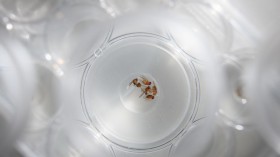Researchers from the University College London (UCL) have finally deciphered the recipe for painlessness with the help of genetically modified mice.
Pain – for humans and mice – is passed along nerve cell membranes through "channels," before reaching the nervous system. In human, it falls to sodium channel Nav1.7 to signal pain, which explains why people born without a functioning Nav1.7 do not feel pain. One common corelary to such a genetic mutation is the production of unusually high levels of opioid peptides, which are simply short sequences of amino acids that bind to opioid receptors in the brain, according to the university's news release.
All of this lead researchers to focuss on Nav1.7 and the role opioid peptides play in painlessness. For their study, they adminsitered naloxone, an opioid blocker, to mice lacking Nav1.7 and found it regenerated their ability to feel pain. They did the same with a 39-year-old woman who possed a rare genetic "painlessness" mutation, and she too was able to feel pain for the first time in her life.
Now researchers are suggesting that opioid peptides could be used to end chronic pain.
"After a decade of rather disappointing drug trials, we now have confirmation that Nav1.7 really is a key element in human pain," Professor John Wood, senior author from UCL, explained in the release. "The secret ingredient turned out to be good old-fashioned opioid peptides, and we have now filed a patent for combining low dose opioids with Nav1.7 blockers. This should replicate the painlessness experienced by people with rare mutations, and we have already successfully tested this approach in unmodified mice."
Broad-spectrum sodium channel blockers have been used as local anesthetics before, but they are not effective on a long-term basis and can even cause complete numbness or other serious side effects if used too frequently. On the other hand, opioid painkillers, such as morphine, are highly effective in reducing pain, but often lead to an unhealthy addiction and higher pain tolerences; as the body becomes accustomed to the drugs and higher doses are required to achieve the same results.
"Used in combination with Nav1.7 blockers, the dose of opioid needed to prevent pain is very low," Professor Wood added in the university's release. "People with non-functioning Nav1.7 produce low levels of opioids throughout their lives without developing tolerance or experiencing unpleasant side-effects. We hope to see our approach tested in human trials by 2017 and we can then start looking into drug combinations to help the millions of chronic pain patients around the world."
The study was recently published in the journal Nature Communications.
For more great nature science stories and general news, please visit our sister site, Headlines and Global News (HNGN).
-Follow Samantha on Twitter @Sam_Ashley13
© 2024 NatureWorldNews.com All rights reserved. Do not reproduce without permission.





